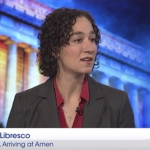Ok. There’s been a controversy brewing on the “Is it so hard not to desecrate the Eucharist” post (part of the ongoing discussion of when, if ever, sacrilege is an appropriate form of protest). March Hare has been making the case that P.Z. Myers’s desecration of a consecrated wafer was meant to debunk the Catholic doctrine of transubstantiation.
March Hare wrote:
Should Catholics not be called out on the fact their faith decrees that a cracker becomes human flesh by a priest saying magic words? Or that the consumption of an actual body (according to their belief) is a key part of their union with the Church i.e. cannibalism.
Magic and cannibalism. And they call the African religions voodoo.Incidentally, it has been tested scientifically, it is still a cracker after consecration, there is no human DNA in it. Catholic magic words, like all magic words, have no supernatural effects.
I’m not under the impression that any Catholics think that they receive the Host as piece of flesh complete with DNA or that the Communion chalices are full of red blood cells, platelets, and plasma. After all, if March Hare’s contention were true, Myers’s attempting debunking would be superfluous, as long as Catholics could distinguish between the taste of wine and the taste of blood.
There’s been some counter-citing in thread, and I want to clear things up. To start with, I consulted noted Catholic reference Wikipedia, in which the first paragraph of the article on Transubstantiation reads:
In Roman Catholic theology, transubstantiation (in Latin, transsubstantiatio, in Greek μετουσίωσις metousiosis) means the change of the substance of host bread and sacramental wine into the substance of the Body and Blood (respectively)[1] of Jesus in the Eucharist, while all that is accessible to the senses (accidents) remains as before.[2][3]
This tracks pretty well with some of the explanations I’ve heard from Catholics, but I wouldn’t mind getting an explanation that’s written by a source that’s a little less small-c catholic than Wikipedia but which is still targeted toward laypeople. I’ve asked the folks at the Catholic Spitfire Grill for help, but if any Catholic reading this blog has a good link or wants to write a quick, well-sourced guest post, let me know.
March Hare was citing from the Catechism of the Catholic Church in the last thread, but according to a plausible argument by Charles, he may have been misunderstanding terms that used differently in theology and in everyday life. Here’s what Charles had to say:
March Hare: I think part of th issue seems to be that from basic principles you reject theological explanation, so rather than saying “the idea that something could have an ‘essence’ and a ‘substance’ is absurd” or “a physical object cannot have a ‘spiritual presence'” you redefine the doctrine to meet your rationalistic/mechanistic world view, and attack that as absurd.
Now I am not saying your critique of the concept of transubstantiation might not be valid, I am saying that it is overly simplistic, and betrays a complete misunderstanding of what catholics actually believe…As to whether Catholics in the pews are expected to get this, I can tell you I have never met a Catholic from the pew on up to the priest who believed/claimed to believe/thought anyone believed/or thought the church taught anything like what you subscribed. AS to lay understanding I would think one of the points is that it is a MYSTERY! I find it odd that you can accept lay understanding of a triune godhead, but not that a piece of bread contains a spirit!
So let’s take one last round of links and then clear all this up.
















